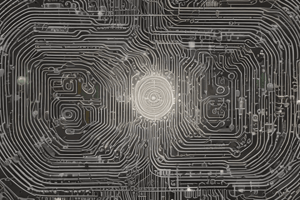Podcast
Questions and Answers
What is the expected shape of the I-V graph for a diode?
What is the expected shape of the I-V graph for a diode?
- A straight line passing through the origin
- A curve with a negative gradient
- A curve with a positive gradient
- An exponential curve (correct)
What happens to the resistance of an ohmic resistor when the temperature increases?
What happens to the resistance of an ohmic resistor when the temperature increases?
- It becomes infinite
- It remains constant
- It increases (correct)
- It decreases
A circuit has a 24V battery and a resistor of 12Ω. What is the current flowing through the circuit?
A circuit has a 24V battery and a resistor of 12Ω. What is the current flowing through the circuit?
- 4A
- 6A
- 2A (correct)
- 1A
What is the power consumption of a device that operates at 120V and draws a current of 2A?
What is the power consumption of a device that operates at 120V and draws a current of 2A?
If the resistance of a wire is directly proportional to its length, what happens to the resistance when the length of the wire is doubled?
If the resistance of a wire is directly proportional to its length, what happens to the resistance when the length of the wire is doubled?
How can you determine the threshold voltage of a diode from its I-V graph?
How can you determine the threshold voltage of a diode from its I-V graph?
What is the main difference between the I-V characteristics of a filament lamp and an ohmic resistor?
What is the main difference between the I-V characteristics of a filament lamp and an ohmic resistor?
If the power consumption of a device is 150W and it operates at a current of 5A, what is the voltage across the device?
If the power consumption of a device is 150W and it operates at a current of 5A, what is the voltage across the device?
What is the mathematical expression of Ohm's Law?
What is the mathematical expression of Ohm's Law?
What is the unit of electric current?
What is the unit of electric current?
What is the relationship between electrical power and voltage?
What is the relationship between electrical power and voltage?
What happens to the resistance of a filament lamp as the voltage increases?
What happens to the resistance of a filament lamp as the voltage increases?
What is the equation that relates potential difference, current, and resistance?
What is the equation that relates potential difference, current, and resistance?
What is the formula for calculating electrical power?
What is the formula for calculating electrical power?
What is the current flowing through a circuit if the potential difference is 9V and the resistance is 3Ω?
What is the current flowing through a circuit if the potential difference is 9V and the resistance is 3Ω?
What is the power consumption of a device with a potential difference of 10V and a current of 3A?
What is the power consumption of a device with a potential difference of 10V and a current of 3A?
Flashcards are hidden until you start studying
Study Notes
Definitions
-
Ohm's Law is a fundamental principle in electricity that relates voltage, current, and resistance.
-
Ohm's Law can be mathematically expressed as V = I × R, where V is voltage, I is current, and R is resistance.
-
Ohm's Law can be applied in a circuit to calculate voltage, current, or resistance if the other two values are known.
-
Electrical power is the rate at which electric energy is transferred or converted.
-
The formula for calculating electrical power is P = V × I, where P is power, V is voltage, and I is current.
-
Power is related to voltage and current, as it depends on the product of voltage and current.
-
Potential difference is the difference in electric potential between two points in a circuit.
-
Potential difference is measured in volts (V) and is often denoted by the symbol ΔV.
-
Potential difference is important in a circuit as it drives the flow of electric current.
-
Electric current is the flow of electrons through a conductor.
-
The unit of electric current is the ampere (A).
-
Current flows in a conductor due to the movement of charged particles, such as electrons.
Equations
-
Ohm's Law equation is V = I × R, relating voltage, current, and resistance.
-
If a device has a voltage of 12V and a current of 2A, the resistance can be calculated using Ohm's Law: R = V / I = 12V / 2A = 6Ω.
-
The equation for electrical power is P = V × I, where P is power, V is voltage, and I is current.
-
If a device has a potential difference of 10V and a current of 3A, the power consumption can be calculated as P = V × I = 10V × 3A = 30W.
-
The equation relating potential difference, current, and resistance is V = I × R.
-
Given a potential difference of 9V and a resistance of 3Ω, the current can be calculated as I = V / R = 9V / 3Ω = 3A.
-
Current can be calculated using the equation I = Q / t, where I is current, Q is charge, and t is time.
-
If a circuit has a charge of 15C passing through it in 5 seconds, the current can be calculated as I = Q / t = 15C / 5s = 3A.
Practical Experiments
-
The setup for an experiment to investigate the current-voltage characteristics of a filament lamp involves connecting a filament lamp to a power source and varying the voltage while measuring the current.
-
The graph of current against voltage for a filament lamp is expected to be non-linear, with current increasing rapidly at low voltages and slowing down at higher voltages.
-
The resistance of a filament lamp changes as the voltage increases, with the lamp becoming less resistive at higher voltages.
-
The setup for an experiment to measure the current-voltage characteristics of a diode involves connecting a diode to a power source and varying the voltage while measuring the current.
-
The expected shape of the I-V graph for a diode is non-linear, with the current increasing rapidly at a certain voltage (the threshold voltage) and then increasing more slowly.
-
The concept of forward and reverse bias in a diode refers to the direction of the voltage applied to the diode, with forward bias allowing current to flow and reverse bias blocking current.
-
The procedure to determine the current-voltage characteristics of an ohmic resistor involves connecting the resistor to a power source and varying the voltage while measuring the current.
-
The expected relationship between current and voltage for an ohmic resistor is linear, with current directly proportional to voltage.
-
The resistance of an ohmic resistor behaves with changes in temperature, increasing as the temperature increases.
-
The experiment to measure the resistance of a length of wire involves connecting the wire to a power source and varying the length of the wire while measuring the resistance.
-
The length of the wire affects its resistance, with longer wires having higher resistance.
-
If the resistance of a wire is directly proportional to its length, doubling the length of the wire will double its resistance.
Application and Analysis
-
Given a circuit with a 24V battery and a resistor of 12Ω, the current flowing through the circuit can be calculated using Ohm's Law: I = V / R = 24V / 12Ω = 2A.
-
If the resistance in the circuit is increased to 24Ω, the new current can be calculated as I = V / R = 24V / 24Ω = 1A.
-
The power consumption of a device operating at 120V and drawing a current of 2A can be calculated as P = V × I = 120V × 2A = 240W.
-
If the power consumption of a device is 150W and it operates at a current of 5A, the voltage across the device can be calculated as V = P / I = 150W / 5A = 30V.
-
From an I-V graph of a diode, the threshold voltage can be determined by finding the voltage at which the current begins to increase rapidly.
-
The I-V characteristics of a filament lamp differ from that of an ohmic resistor in that the lamp has a non-linear relationship between current and voltage, while the resistor has a linear relationship.
Studying That Suits You
Use AI to generate personalized quizzes and flashcards to suit your learning preferences.




